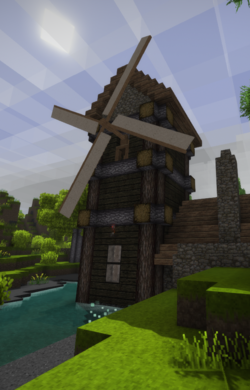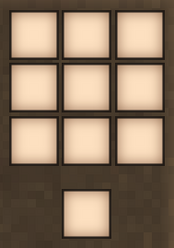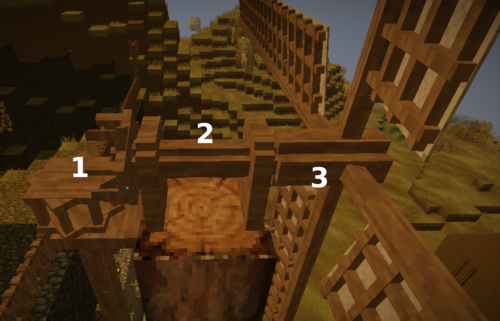Windmill
A windmill is a multi-block structure used to harness wind and transform it into mechanical power. Currently, wind power can be used to automate querns, helve hammers, and pulverizers. Out of these, only the quern can be used manually, without any need for mechanical power.
Considerations for the Structure
Clearance
A structure with sufficient height and clearance is needed to accommodate the sails, the power train, and associated equipment e.g. quern, helve hammer, etc. Sails too low to the ground may not receive enough wind speed to generate any wind power. Likewise, a structure with insufficient clearance might prevent the sails from rotating freely. A windmill can be added onto existing structures as long as it meets the previously mentioned qualifications. A set of sails that barely clears the ground might have problems in winter: sails that hit a block such as snow break, dropping the sails to the ground. If the player walks through the snow below the rotor before the items despawn, they might recover all of the dropped sails
Height and Location
The location and height of the structure can also affect the amount of power generated. Windspeed increases 1% per block above sea level + 10, with a maximum bonus of 50% at 60 blocks above sea level. Put another way: Once you get above sea level + 10, each block of elevation adds 1% to your windmill's potential windspeed, to a maximum of 150%.
For a world with default height of 256 blocks, sea level would be Y-level 110. Above Y 120, a windmill starts to get the height bonus: a rotor at Y 121 could reach up to 101% windspeed, and a rotor at Y 170 could reach up to 150% windspeed.
Conversely, wind speeds below sea level are reduced 50% at 4 blocks below and 66% at 8 blocks below, rapidly decreasing towards 100% reduction.
Note that wind speeds naturally vary; at times there may be no wind at all. If there is zero wind, a tower with 150% potential windspeed would still produce no power.
On a technical level, wind speed varies from region to region and is linearly interpolated between the 4 nearest weather regions, for a given block location.
Materials
To create a windmill, a player needs:
Windmill rotor
The mechanism that supports the rotating sails. Each windmill requires one rotor to work, and each rotor can support up to 5 sets of sails.
| Ingredients | Crafting Recipe |
|---|---|
| 1x Hammer 1x Chisel 2x Log 1x Resin 1x Fat |
Set of Sails
The wind-catching part that allows for the generation and harness of wind power. Each set of sails will increase the power output by 20% and require one full block of clearance. If the sails do not have space to move freely, they will break and fall to the ground below.
| Ingredients | Crafting Recipe |
|---|---|
| 6x Stick 4x Linen |
Sails are constructed in sets, with one set containing four sails. that means each set takes:
| Sails | 1 set | 2 sets | 3 sets | 4 sets | max 5 sets |
|---|---|---|---|---|---|
| Sticks | 6 | 12 | 18 | 24 | 30 |
| Linen | 4 | 8 | 12 | 16 | 20 |
With the mouse cursor over the rotor, the Block info HUD will display the current windspeed and potential power output. One set of sails at 100% windspeed produces 20 kN of power; two sets produce 40 kN, and so on. But if the windspeed drops to 50%, two sets of sails would produce only 20 kN.
- A single set of sails (20 kN) can power a quern (slowly) with a strong breeze.
- A single set of sails can power a pulverizer (slowly) with a strong breeze.
- A single set of sails isn't enough to budge a helve hammer at sea level, even with storm-level winds. 2 sets of sails may be barely enough to power a helve hammer slowly, with a strong breeze. 3 sets of sails can get a helve hammer moving with a medium breeze, barely.
More sails doesn't necessarily lead to higher speed. Rather, more sails can make the difference between getting a machine moving in lower and lower windspeeds. One way to achieve higher speeds for machines is to "change gears" like a street bicycle. See mechanical power for details.
Wooden Axles
Used to transmit the wind power in a straight line. These may be placed vertically or horizontally in any of the cardinal directions. However, a supporting block is often required before an axle can be placed; the support may then be removed.
| Ingredients | Crafting Recipe |
|---|---|
| 1x Hammer 1x Chisel 1x Log 1x Fat |
Angled Gears
Allows the mechanical power to make a right angle turn by connecting a horizontal axle to a vertical one. Usually optional, but often needed depending on the design of the power train.
| Ingredients | Crafting Recipe |
|---|---|
| 1x Hammer 1x Saw 2x Stick 1x Chisel 1x Resin 1x Log 1x Fat |
Building the Windmill
The windmill requires at least 5 blocks of vertical space between the rotor and the ground or any other solid block to accommodate a full complement of 5 sets of Sails.
For power train designs, see mechanical power.
Video Tutorials
| How To Build A Windmill & Automate a Quern. |
|---|
| Ores, metals and minerals | |
|---|---|
| Guides | Ore Deposits • Metals |
| Metals | Copper • Iron • Meteoric iron • Gold • Silver • Lead • Tin • Zinc • Bismuth • Titanium (Ilmenite) |
| Alloys | Bronze (Tin bronze, bismuth bronze, black bronze) • Steel • Brass • Solder (Lead solder, Silver solder) • Molybdochalkos • Cupronickel • Electrum |
| Minerals | Alum • Borax • Cinnabar • Coal • Halite (Salt) • Lapis lazuli • Quartz • Saltpeter • Sulfur • Sylvite (Potash) |
| Tools | Pickaxe • Hammer • Prospecting Pick • Crucible • Forge • Ore blasting bomb • Quern • Anvil • Bloomery • Helve hammer • Pulverizer |
| Other | Gemstones |
| Related mechanics | Panning • Mining • Clay forming • Casting • Smithing • Steel making |
| Wiki Navigation | |
|---|---|
| Vintage Story | Guides • Frequently Asked Questions • Soundtrack • Versions • Controls |
| Game systems | Crafting • Knapping • Clay forming • Smithing • Cooking • Temperature • Hunger • Mining • Temporal stability • Mechanical power • Trading • Farming • Animal husbandry |
| World | World generation • Biomes • Weather • Temporal storms |
| Items | Tools • Weapons • Armor • Clothing • Bags • Materials • Food |
| Blocks | Terrain • Plants • Decorative • Lighting • Functional • Ore |
| Entities | Hostile entities • Animals • NPCs • Players |
| Miscellaneous | List of client commands • List of server commands • Creative Starter Guide • Bot System • WorldEdit • Cinematic Camera • Adjustable FPS Video Recording • ServerBlockTicking |


